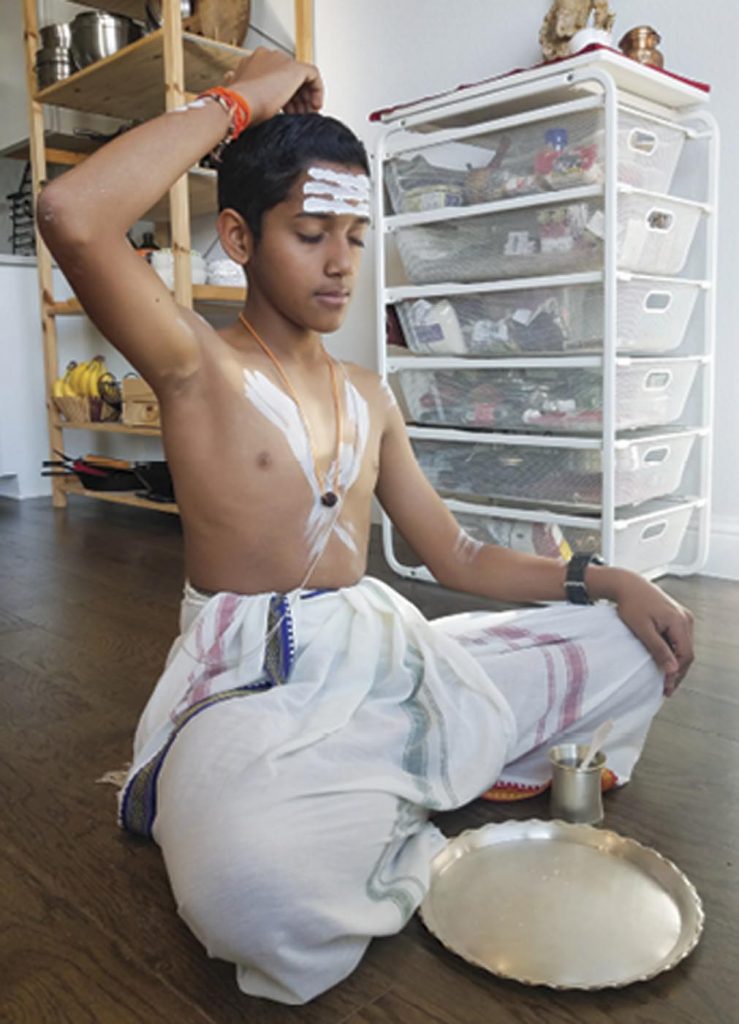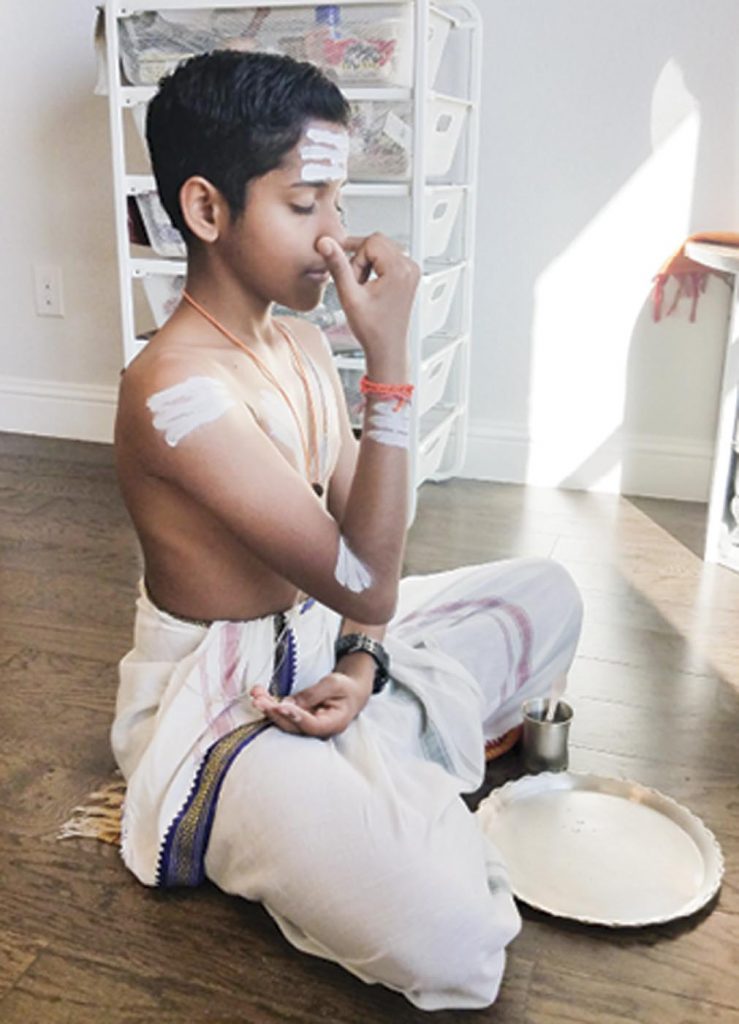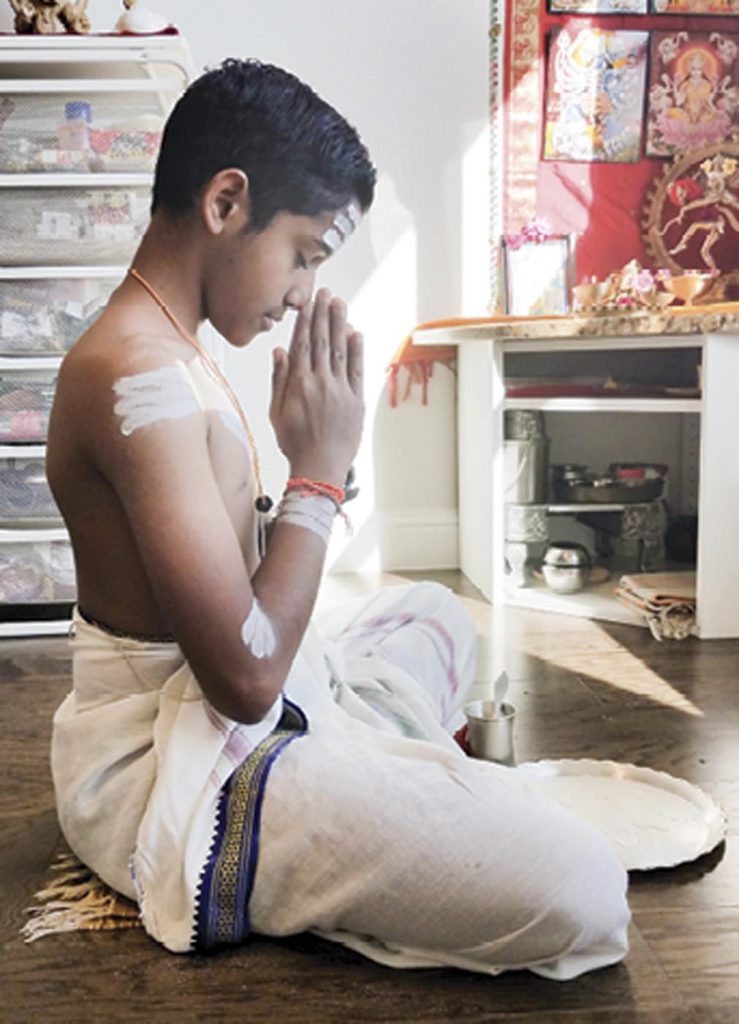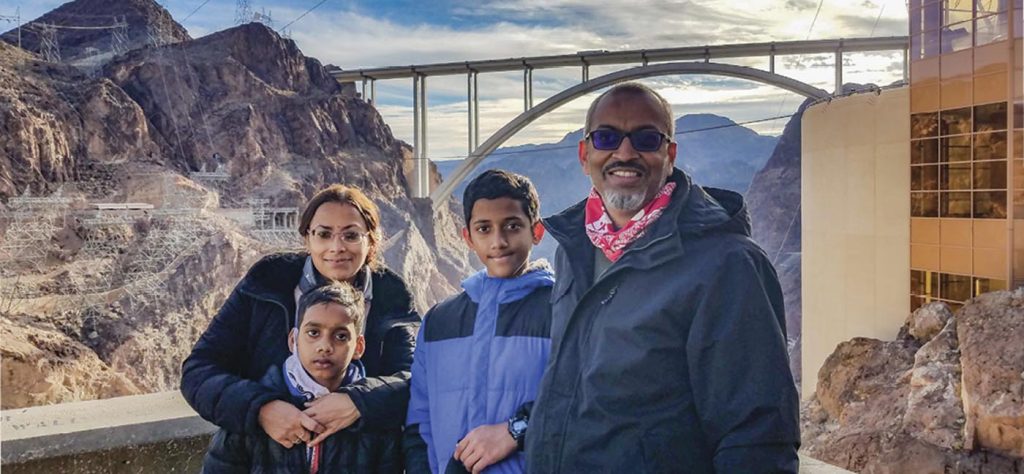One youth’s discovery of the power and challenges of daily sadhana
One wet morning this spring, on the day of my sixth-grade Texas state exam, my dad and I woke up early to get ready to leave. This past fall we’d moved but had not yet changed my school, which was now an hour’s drive away. Just before we left, I woke my mom up so that I could offer my dad and her namaskaram (prostration) to receive their blessings. Mom asked if I had done my sandhya vandanam, to which I responded, “Yes, Amma.” For more than a year, it has been instilled in me that no matter what, sandhya has to be observed. So there I was.
Sandhya vandanam is a Hindu ritual performed three times a day. The sandhyas are those times (kala) in a day when our prana (vital energies) are balanced in the external nature. There are four sandhyas: 1) morning, pratah kala sandhya; 2) noon, madhyanah kala sandhya; 3) evening, sayana kala sandhya; and 4) midnight, kali sandhya. These are auspicious times to connect with the Divine and increase one’s awareness. Therefore, the ancient rishis blessed us with this practice to bring us closer to Ishwara (God).
The Ritual of Sandhya Vandanam
Sandhya vandanam is performed in the first three sandhyas of a day, accompanied with kriyas (actions) while chanting mantras. The key steps in this daily ritual, as practiced by the followers of the Taittiriya Krishna Yajurveda tradition, are:
1. Sankalpam is where one commits to the universe their intent to perform sandhya vandanam.
2. Marjanam is a purification act where the seeker asks for forgiveness for sins committed unintentionally. For any sins committed with intention, the law of karma will take care of those.
3. Tarpanam is an offering of jala (water) to the various devas and grahas, seeking their protection.
4. Gayatri Japa Sankalpam is where the seeker promises to the Universe that he will now perform the Gayatri Japa.
5. Pranayama are breathing exercises to balance the prana vayu, air.
6. Gayatri Japa is the repeated chanting of the Savitur Gayatri mantra. The number of times the mantra is repeated depends on the family’s tradition. In my family, we chant 108 times in the morning (about 15 minutes), 64 times in the afternoon, and 32 times in the evening.
7. Samashti Abhivadanam is seeking the blessings of the various Devatas, such as Surya, Yama, Varuna, Bhoomi Devi, Digdevatas (guardian Deities of all directions), and others.
8. Samarpanam is the final step, where one seeks forgiveness for any mistakes during the ritual, and offers it all, including ahamkara (ego), to Ishwara (God).



Initiation: Upanayanam Samskar
For one to get initiated into sandhya vandanam, they have to go through a rite of passage called upanayanam samskar. Upanayanam marks the beginning of the study of the Vedas, and brahmacharya (life of a celibate student). In ancient times, after upanayanam, the guru would take the child to his gurukulam (ashrama) to teach the Vedas and other holy scriptures over the course of many years. In turn, the child gave up material comforts of the family home, and vanity (such as hair) to live an austere life in their guru’s ashrama.
During the upanayanam ceremony, a child is given a yagnyopavita (sacred thread, also known as janeu or pulnool), and the most auspicious Gayatri mantra by his father or grandfather. The ceremony typically lasts two days and has many elements that hint toward the ancient practice of leaving the family home to join the guru in his ashrama. For example, one of the steps in the ceremony involves partaking of what was supposed to be a last meal with your mother before leaving her. While traditional gurukulams are not a thriving institution where I live, this step still made me think about what it would have been like in the earlier times for a boy like me to leave his family behind in the pursuit of learning.
Another step from the ceremony that left its mark on me was that of the bhikshatan ritual. The way our culture was set up, we never expected brahmins to earn their living. They were expected to pursue the Divine with full attention and were expected to benefit the larger society with knowledge and wisdom attained through their pursuits. So a guru, his ashrama, and all his disciples were sustained through anna (grains, literally) given in bhiksha (donation) by the rest of the society. A newly initiated brahmachari was expected to get the first bhiksha of anna from his mother and elderly ladies in his family. Thus, I, too, had to hold out a container and seek alms from my mother with a call “bhavati bhiksham dehi.” She was only too happy to bless me with anna, but it was humbling nonetheless.
A person initiated through upanayanam ceremony is considered a dwija—literally, one who is twice born. The first birth is from the mother’s womb; the second refers to the new and, hopefully, more aware life with the initiation into the study of Veda Shastra (scriptures). This self transformation is brought upon not just by the lifestyle changes needed to support the study of the Veda, but also by a disciplined spiritual practice of sandhya vandanam.
The Gayatri Mantra
The most important part in the sandhya vandanam ritual is Gayatri japa, which is mental recitation of the Savitur (Divine Sun) Gayatri given in the Rig Veda. Here is a transliteration:
Aum tat savitur varenyam.
Bhargo devasya dhimahi,
dhiyo yo nah prachodayat
This mantra was given to us by Brahmarishi Vishwamitra. Here, Gayatri is the chhanda (meter) of the mantra, signifying that it has twenty-four syllables divided into three parts with eight syllables each. There are mantras in this Gayatri chhanda for other Gods as well, though the term Gayatri Mantra is commonly used to refer to Savitur
Gayatri. Nowadays, the mantra is preceded by “Bhur Bhuvah Suvah,” but I am told that an uninitiated person should never use bijakshara with the mantra, and an initiated one should never reveal the bijakshara to anyone. So I’ve not given the bijakshara with the mantra here.
Over the ages, many gurus and yogis have commented on the meaning of this mantra; although, as per my mom, one has to meditate on a mantra for a considerable length of time to fully internalize it. Still, here is the literal translation of this mantra as given to me by my mother:
“That Supreme Bliss, the Radiant One who guides the intellect of the devas, may such (Savitur) inspire our intelligence.”
Mental recitation of this mantra shall guide an individual’s intellect as one goes through their daily life. Mother always tells me that mind is the basis of everything. That we elevate ourselves to higher levels of consciousness or descend into lower realms based on how our intellect guides us. No wonder this mantra is the first part of the Veda that is taught to an initiate. Once the intellect is set on the right track, other things take care of themselves in due course of time.
Mental recitation of this mantra shall guide an individual’s intellect as one goes through their daily life.

Mother always tells me that mind is the basis of everything. That we elevate ourselves to higher levels of consciousness or descend into lower realms based on how our intellect guides us. No wonder this mantra is the first part of the Veda that is taught to an initiate. Once the intellect is set on the right track, other things take care of themselves in due course of time.
Personal Transformation
Apart from the spiritual practices of sandhya vandanam, and the study and recitation of Vedic hymns, as a brahmachari, one is supposed to follow other lifestyle habits such as not sleeping when the sun is up, not eating food partaken of by others, etc. My personal daily routine changed, as I now strive to wake up at sunrise to perform my morning sandhya vandanam. Similarly, I keep reminders to do madhyanam at noon. I initially had difficulty remembering when in the middle of my schoolwork. I also avoid taking naps during the daytime. When we are on family vacations, I am unable to carry my accouterments. So, I sit on a flat seat, usually a table in the hotel room, and just do the most important part of the sandhya vandanam, which is Gayatri japa.
I admit that doing school from home in the times of Covid has helped me practice sandhya vandanam three times a day with regularity. However, I have been asked by my parents to commit to practicing the ritual at least twice a day, during morning and evening kala, even if I’m away from home during the noon time in the years to come.
The discipline involved in performing sandhya vandanam thrice a day brings its own benefits and challenges. For instance, when I am in the middle of something boring or difficult, taking a break to do sandhya vandanam recharges me. On the other hand, it is sometimes annoying when I have to interrupt something fun to observe the ritual. All things said, it does bring a lot of discipline in my life.
Not a lot of people around me practice sandhya vandanam. I have two friends who got initiated with upanayanam around the same time as I. But neither of them perform sandhya vandanam, and one of them also doesn’t wear his yagnyopavita. Similarly, most men or children my age in my family do not perform daily sandhya vandanam. Of all the people I know, my father is the only person who does it with discipline each day.
Due to our differing daily routines, my father and I don’t do our morning and noon practices together. However, we have a family tradition in place where my father, my younger brother and I observe our evening practice together each day. My younger brother is not yet initiated, but Dad still makes him sit down with us to have him practice asana (sitting still). I enjoy this time together because my father explains the meanings of each mantra and their Sanskrit roots, but also particularly because he tells us stories from the Puranas and Itihasas (the Ramayana and Mahabharata). In this way he is teaching us life lessons that he urges my brother and me to always remember. I will always cherish this aspect of sandhya vandanam. I hope to pass on this knowledge to future generations.

Why Practice Sandhya Vandanam?
As I observe the world around me and see that not many are following this age-old spiritual tradition, naturally I questioned my parents as to why they insist that I should continue this practice. I was hoping that my father, being someone who has done it consistently, would be able to help me understand how it has helped him personally.
In his own words: “Certainly, the least that any sadhana does is instill discipline. I was initiated into sandhya at the age of seven. That was the one thing my mother made sure that I do no matter what—vacation or school or what have you. I believe that the discipline it cultivated in me at a young age, of doing something on a daily basis without allowing the mind to make excuses, has helped me in other areas of my life.
“But there is more. The ritual makes me realize the benevolence of all the beings—Devas, grahas, gotra rishis, pitris (ancestors)—who play a role in letting my life flourish in this plane. It gives me an opportunity to thank them properly each day. Also, the ritual offers a reminder that all my actions have implications in terms of karma, whether I recognize them as such or not. Over the years, this has made me more aware of my actions throughout the rest of the day. To add to these, I get to meditate. That is an icing on the cake for me personally.”
My mom tells me that she promised herself to initiate me, her oldest, into sandhya vandanam even before I was born. I was eager to know the reason behind her conviction. So, I asked Amma. She asked me in return: “Say, you wanted to learn a sadhana of the Greek God Zeus, where would you go, Gunap?” I did not have an answer. A quick Google search led me to understand that there are not many people walking Earth right now who worship the Gods of the ancient Greek faith.
“Exactly,” she said, and then continued further, “All classical religions—Egyptian, Greek, Native American, Mesoamerican religions, Roman, you name it—are all dead. Today if you wish to learn about them, you will need to visit a museum and see a few exhibits about the lives they lived and the beliefs they held, and call it a lesson. The only surviving classical culture is Sanatana Dharma (eternal path). This long, continuous thread of civilization we call Sanatana Dharma will break the day we stop practicing it.”
So, there it is. Clarity and conviction of my parents is enough to take me further down this path. While I await the longer-term gain of higher awareness, I am content to practice tri kala (thrice daily) sandhya vandanam to keep this spiritual tradition alive for one more generation.

About the Author
Gunap Sriganesh is a middle schooler living in North Texas. When he is not at school, Gunap enjoys playing tennis, cooking, and building things around the house. He thanks his mom for helping with this article.

Thank you Gunap Sriganesh. You are an inspiration for grownups like me 🙂
Proud & so Happy to know that the tradition is still kept alive and the values are being instilled in young minds like You who will further pass on to future generations.
Guess you are very young but as a grown up I feel so good to learn & take motivitation from Youths Like You. Stay focused & you have a Blessed Life.
Koti Koti Pranamam! to You & your Parents.
This was so inspiring, thank you thank you thank you.
Love’n it. Love the way you sharing this and how you auto realised by the power of sandhya vandanam
So well explained, that you can see the clarity of a young men who is committed to such practices.
I am from Spain coming from a Christian background, so in my family we didn’t have this tradition, but I was lucky to meet Shantala Sriramaiah and Eddie Stern and other teachers whom have introduced GAYATRI UPASANA.
A wonderful practice that leads one to the patch of clarity.
lol the photo is inverted
About the main photograph in this article depicting two boys doing Sandhya the one in the front is wearing yagnopavit(janau)
on his left shoulder! This is absolutely wrong, making me to think that he is a fake Brahmin. Do you have ant explanation?
Aloha Jay. You are correct. This is a big error. The boy was wearing the thread correctly, but the digital photo was “flipped” horizontally at some point in the production process. Our apologies.
I feel very happy while reading the articles. And I am feeling very proud that the youths are following the Sanatan Dharma culture. Best wishes for such bright mind.
wow, so much to learn …. thank you.
Superbly written and explain touching upon the key questions which arise in anyone who follow Sandhya. Liked the notes on Upanayanam as well. And the point where it says “Mother always tells me that mind is the basis of everything” is well put, which we could rephrase as “thoughts is the basis of everything” (taking from Yoga-Vasistha). The finishing lines on the classical religions is such a important revelation ! Thanks for such a sweet beautiful article and our classic ritual!
Nicely explained and motivational.
I am happy that the author covered the topic very well and with lots of love and reverence.
Very very nice. But no mention of Arghya Pradaanam.
👌
It is inspiring to see clarity & early interest.
thank you so much.
I am Delirama Sharma, middle schooler like you, doing Sandhya thrice everyday in the USA. It’s great to see people like me.
EXCELLANT.
Glad to see young writer’s and the parents’ especially mother’s enthusiasm in keeping up with tradition and discipline.
I also had my ‘ceremony’ when I was studying 10th (late!) along with my sister’s marriage.
Almost only at age of 55, I truly understood not the rituals are important but the ‘inner’ truth of Sun Salute, Pranayama (breathing) and ‘Gayatri’ Meditation.
My family is very religious, (nit like Grandparents’Orthodox’ and god fearing.
I became an Atheist (not the ‘Dravida’ style ) but lost faith in the rituals and god based on many incidents happened to very close ones. I dont believe in after life or Karma – yes one has to be disciplined and do the right thing not because ‘someone’ is watching but ‘self realized’.
I wish I was explained in depth (not sure young mind would had accepted), I guess every age and phase of life everyone experience different circumstances.
Unfortunately our Society as well as Politicians, Educational leaders confuse the young minds and give them opportunity to explore naturally. Important life skills are not taught – left for you to learn on your own. Inspite of million years of evolution only humans still do not know how live with Environment (universe)
Seasons – for lack of basic understanding of human body
brain, thyroid gland (metabolism), Liver (second brain) – By ‘keeping’ secret real purpose of Sandhya Vandanam is lost in rituals.
Even Islam followers practice 5 times Namaz even today – how many Hindus truly practice Sandhya Vandanam.
My point is any one can practice any religion or rituals but
not fanatical and kill each other in the name of religion or race or color or culture or gender!
By the way if Sandhya Vandanam is good why Women are allowed to practice? why discriminate?
Sorry my intention is not to hurt any sentiment.
Children need to ask questions not blindly follow. Anything Good need to be learned and apply – anything not good need to be dropped without any bias.
Compassion and team work are not encouraged – selfishness , competing at any cost to get ahead is being promoted – greed and excess consumption (why NET Zero? )
Educated PhDs ‘smartly’ find loop holes and exploit the innocent (Financial Tsunami and now AI).
Need checks and balances and Ethical guardrails.